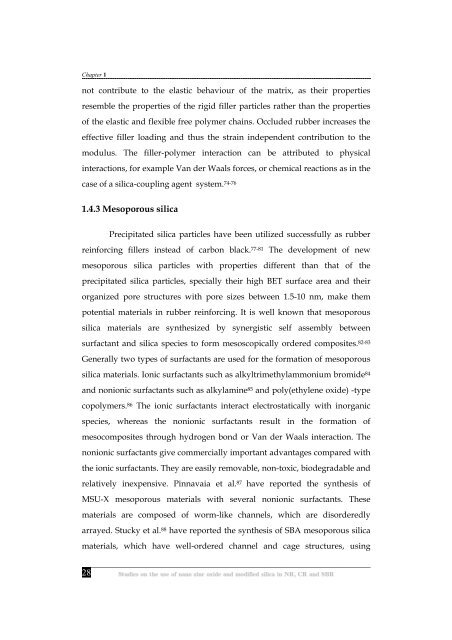Studies on the use of nano zinc oxide and modified silica in NR, CR ...
Studies on the use of nano zinc oxide and modified silica in NR, CR ...
Studies on the use of nano zinc oxide and modified silica in NR, CR ...
You also want an ePaper? Increase the reach of your titles
YUMPU automatically turns print PDFs into web optimized ePapers that Google loves.
Chapter 1<br />
not c<strong>on</strong>tribute to <strong>the</strong> elastic behaviour <strong>of</strong> <strong>the</strong> matrix, as <strong>the</strong>ir properties<br />
resemble <strong>the</strong> properties <strong>of</strong> <strong>the</strong> rigid filler particles ra<strong>the</strong>r than <strong>the</strong> properties<br />
<strong>of</strong> <strong>the</strong> elastic <strong>and</strong> flexible free polymer cha<strong>in</strong>s. Occluded rubber <strong>in</strong>creases <strong>the</strong><br />
effective filler load<strong>in</strong>g <strong>and</strong> thus <strong>the</strong> stra<strong>in</strong> <strong>in</strong>dependent c<strong>on</strong>tributi<strong>on</strong> to <strong>the</strong><br />
modulus. The filler-polymer <strong>in</strong>teracti<strong>on</strong> can be attributed to physical<br />
<strong>in</strong>teracti<strong>on</strong>s, for example Van der Waals forces, or chemical reacti<strong>on</strong>s as <strong>in</strong> <strong>the</strong><br />
case <strong>of</strong> a <strong>silica</strong>-coupl<strong>in</strong>g agent system. 74-76<br />
1.4.3 Mesoporous <strong>silica</strong><br />
28<br />
Precipitated <strong>silica</strong> particles have been utilized successfully as rubber<br />
re<strong>in</strong>forc<strong>in</strong>g fillers <strong>in</strong>stead <strong>of</strong> carb<strong>on</strong> black. 77-81 The development <strong>of</strong> new<br />
mesoporous <strong>silica</strong> particles with properties different than that <strong>of</strong> <strong>the</strong><br />
precipitated <strong>silica</strong> particles, specially <strong>the</strong>ir high BET surface area <strong>and</strong> <strong>the</strong>ir<br />
organized pore structures with pore sizes between 1.5-10 nm, make <strong>the</strong>m<br />
potential materials <strong>in</strong> rubber re<strong>in</strong>forc<strong>in</strong>g. It is well known that mesoporous<br />
<strong>silica</strong> materials are syn<strong>the</strong>sized by synergistic self assembly between<br />
surfactant <strong>and</strong> <strong>silica</strong> species to form mesoscopically ordered composites. 82-83<br />
Generally two types <strong>of</strong> surfactants are <strong>use</strong>d for <strong>the</strong> formati<strong>on</strong> <strong>of</strong> mesoporous<br />
<strong>silica</strong> materials. I<strong>on</strong>ic surfactants such as alkyltrimethylamm<strong>on</strong>ium bromide 84<br />
<strong>and</strong> n<strong>on</strong>i<strong>on</strong>ic surfactants such as alkylam<strong>in</strong>e 85 <strong>and</strong> poly(ethylene <strong>oxide</strong>) -type<br />
copolymers. 86 The i<strong>on</strong>ic surfactants <strong>in</strong>teract electrostatically with <strong>in</strong>organic<br />
species, whereas <strong>the</strong> n<strong>on</strong>i<strong>on</strong>ic surfactants result <strong>in</strong> <strong>the</strong> formati<strong>on</strong> <strong>of</strong><br />
mesocomposites through hydrogen b<strong>on</strong>d or Van der Waals <strong>in</strong>teracti<strong>on</strong>. The<br />
n<strong>on</strong>i<strong>on</strong>ic surfactants give commercially important advantages compared with<br />
<strong>the</strong> i<strong>on</strong>ic surfactants. They are easily removable, n<strong>on</strong>-toxic, biodegradable <strong>and</strong><br />
relatively <strong>in</strong>expensive. P<strong>in</strong>navaia et al. 87 have reported <strong>the</strong> syn<strong>the</strong>sis <strong>of</strong><br />
MSU-X mesoporous materials with several n<strong>on</strong>i<strong>on</strong>ic surfactants. These<br />
materials are composed <strong>of</strong> worm-like channels, which are disorderedly<br />
arrayed. Stucky et al. 88 have reported <strong>the</strong> syn<strong>the</strong>sis <strong>of</strong> SBA mesoporous <strong>silica</strong><br />
materials, which have well-ordered channel <strong>and</strong> cage structures, us<strong>in</strong>g

















